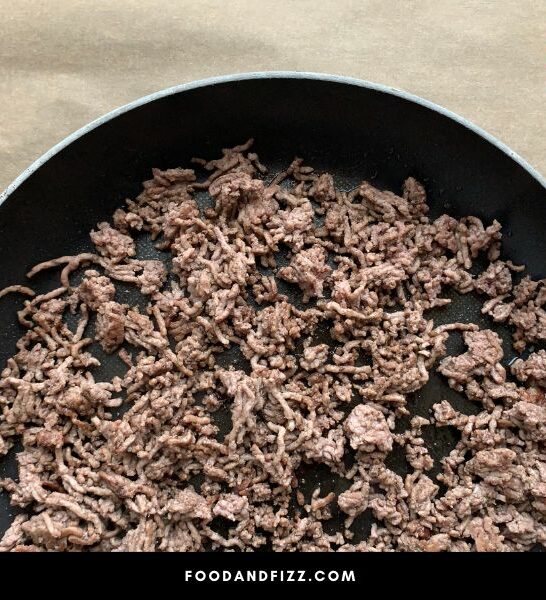Beef naturally changes colors when it is exposed to things like oxygen and heat. From the purple-red hue of beef in the absence of oxygen to the bright cherry red color we so deeply associate with fresh meat, to the brown hue it takes on after we subject it to heat, the transition of beef from raw to cooked is a very predictable change for most of us.
This is why when our cooked ground beef suddenly shows white stuff on the surface after we cook it, we are understandably thrown off. This isn’t part of the plan! What is this white stuff on my ground beef after cooking?
What is the White Stuff on Ground Beef After Cooking?
White stuff appearing in your ground beef after cooking could be due to rendered fat, gristle, or connective tissue, the effects of freezer burn or could be due to parasites or food spoilage.
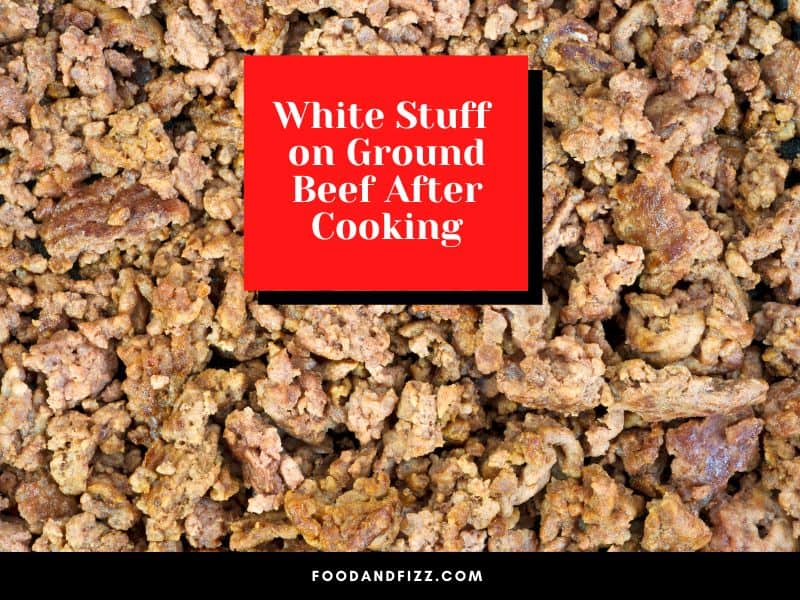
Why Is There White Stuff on My Ground Beef After Cooking?
Seeing white stuff on your cooked ground beef can be a little disconcerting if you have absolutely no idea what to make of the stuff that’s in there. We’re here to help shed light on this mystery.
White stuff on ground beef after cooking can be due to the following:
1. Rendered Fat
Especially if you have refrigerated your ground beef after cooking and it was ground from fatty beef parts, the white stuff you see in your ground beef could actually be the solidified, rendered fat from the ground beef itself.
In colder temperatures, such as in the fridge, fat can solidify and appear white. If you see these white spots on your ground beef after you have cooked it and refrigerated it, there is a big chance it is just the solidified bits of rendered fat.
Heating up your ground beef will melt these solidified fats and make the white spots disappear, making your ground beef the safe shade of brown you expect it to be. If it is due to rendered fat, it is safe to eat.
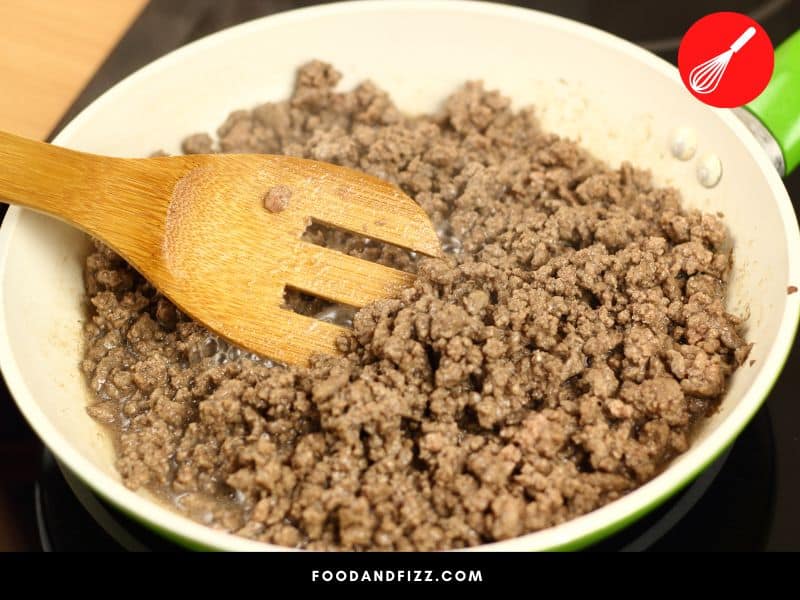
2. Gristle or Elastin
Depending on which beef part your ground beef came from, the white stuff you see in your cooked beef may be parts of connective tissue called gristle.
Gristle, also known as beef cartilage, is a stringy, inedible part of beef that forms the connective tissue that is found in the ligaments and surrounding muscles of the animal.
It is formed from a protein called elastin, which doesn’t break down with heating, unlike the other connective tissue known as collagen. It is stringy, fibrous and tough, and too much of it in beef can give it a texture that’s unpleasant to eat.
More elastin is found in cuts from the shoulder and legs, for example, chuck or top round. If you see white stuff in your cooked ground beef, gristle might be to blame. This is an inedible connective tissue so it probably won’t be a good idea to force yourself to eat it.
3. Freezer Burn
Improperly wrapping your ground beef in the freezer or storing it for a prolonged period of time can cause changes in the color and texture of your ground beef.
Freezer burn is what happens when food dries up and loses moisture while stored in the freezer. When food is not wrapped properly, frozen water molecules are able to escape the food (you see the ice crystals first on the surface of the food, and then eventually they leave the food altogether), resulting in a loss of moisture.
This also allows oxygen in and jumpstarts the process of oxidation, resulting in meat that is dry and dull in color.
When this same meat is thawed, the meat may appear whiter and paler in color than meat that has not experienced freezer burn. If your ground beef has previously been frozen and thawed, freezer burn might be the reason why you see white stuff on it after it has cooked.
It could be due to the discoloration brought about by the loss of moisture and oxidation. In this case, beef will be safe to eat, but expect possible unpleasant flavor and texture changes.
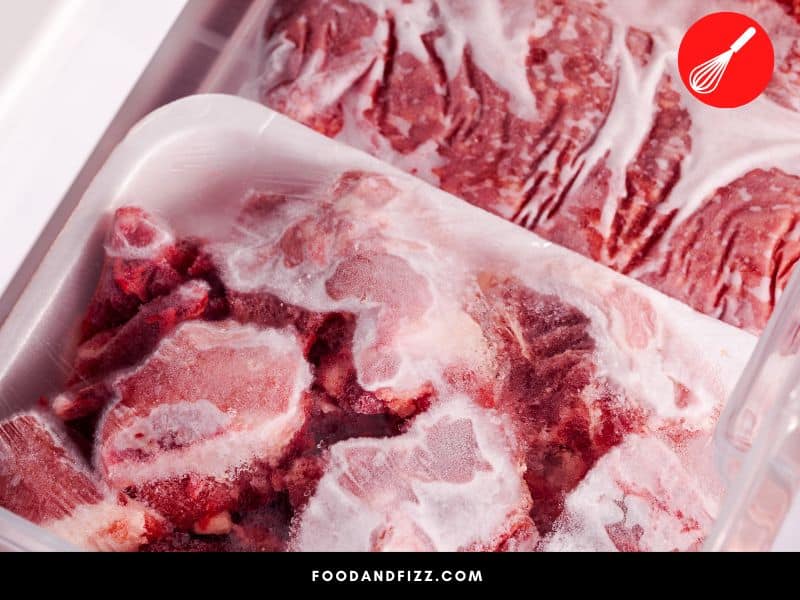
4. Parasites or Food Spoilage
Finally, white stuff in ground beef can be due to the presence of parasites or bacteria that cause food spoilage.
Taenia saginata, also known as beef tapeworm, can contaminate your ground beef and show up as little white strings in your beef. If ingested as eggs or larvae, the tapeworm can keep growing in your intestine for years and can grow up to 12 feet long! Though rarer in the U.S. than pork tapeworm, it can happen with meat sourced from infected animals.
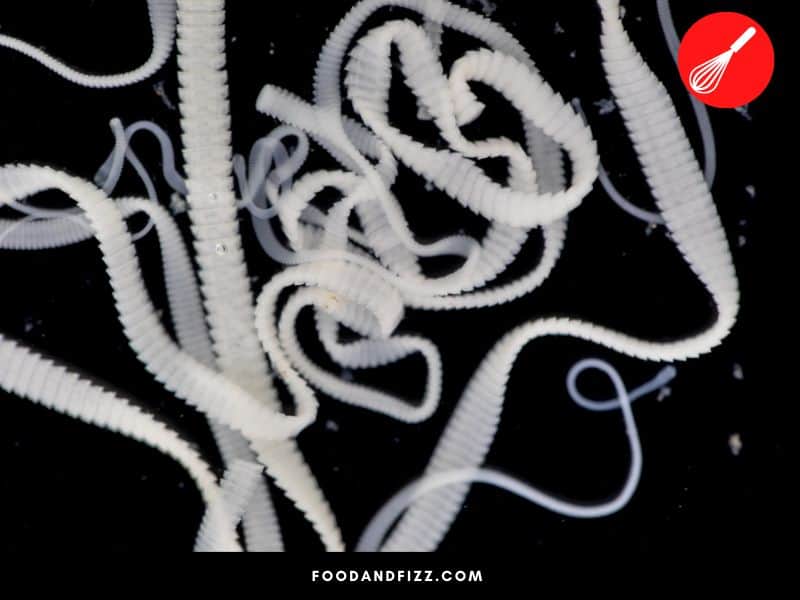
The disease caused by Taenia saginata is called Taeniasis. To prevent this illness, it is important to cook all your meats to a safe internal temperature to kill the parasites and their eggs. Ground beef should be cooked to a temperature of at least 160 °F.
However, if you already see the white strings or stuff in your ground beef that could be tapeworm, I think no amount of cooking to the right temperature can restore its appetite appeal.
Aside from parasites, white stuff in ground beef can also be caused by food spoilage- causing bacteria. When meat goes bad, it undergoes unpleasant appearance, color, texture and odor changes.
White stuff on your ground beef may be due to this as well. If you suspect parasites or food spoilage-causing bacteria, you are better off tossing your ground beef in the bin.
How Long Should I Cook My Ground Beef?
To ensure that your meat is safe to eat, it is a must to cook your meat to a safe internal temperature to kill all harmful bacteria and parasites that might be lurking in the meat.
Raw or undercooked meat can lead to a host of illnesses that can have many long term ill-effects on your health.
According to the USDA, to ensure that your ground beef is safe and won’t make you sick, it should reach at least 160 °F in temperature.
The best way to do this is to use a food thermometer as it can be a little tricky to determine if meat is thoroughly cooked by simply eyeballing it. A meat thermometer is the safest, most accurate measure of the correct temperature of meat.
How Long Does Cooked Ground Beef Last?
Once you cook your ground beef, it may safely stay with you for about 4 days, provided that you properly store it in an airtight container in the fridge. You can store in the freezer if you want, if you wish to save it for later, but it is not advisable to leave it there in the freezer beyond 4 months.
The reason is not because of food safety, as food will indefinitely be safe in the freezer, but more of because after 4 months, it would have lost moisture and deteriorated in quality, making it unpleasant to eat.
Can I Just Remove the White Stuff In Ground Beef and Still Eat It?
You can try but it certainly would not be easy and would take up a lot of time. If it is due to fat, you can simply heat up your ground beef and drain it in a colander to remove the excess fat, so you minimize the amount of white stuff in there.
If it is due to gristle or cartilage, you can try to pick as much of the pieces out if you can, and your ground beef will still be safe to eat.
If it is due to freezer burn, there is not much you can do to change the white stuff, unless you add sauce to your ground beef that will mask the paleness and the whiteness of the meat.
If it is due to parasites or food spoilage, do not think twice and just toss the meat. Don’t risk getting sick as it can potentially have long-term health effects.
How Do I Know That I Can Still Eat My Ground Beef?
I hate wasting food as much as the next person but eating fresh, safe food is of utmost importance all the time. If the ground beef you just cooked or the ground beef you have been saving exhibits some unusual colors, growths, smells, and textures, you should not hold on to it and toss it right away.
Fresh ground beef should be a healthy red when raw and brown when cooked. Uncooked brown ground beef is not necessarily bad, but it means it has been exposed to oxygen for a while, and may not be as fresh. You must cook this ground beef right away so it will not go bad.
Cooked ground beef should have a brown color. If you see any other colors or mold growing on it, toss it. The ground beef is spoiled.
Any off smells on your ground beef akin to rotting eggs, ammonia, or any strong smell that’s not of meat or beef (or the ingredients you used), toss the beef!
Any slimy or sticky texture should also be an indication that the ground beef is no good anymore.
If you spot any of these signs, you are better off tossing your beef in the bin rather than risk getting sick.

What Happens If I Eat Ground Beef That’s Bad Anyway?
Eating bad or undercooked ground beef can make you really sick. As we mentioned earlier, beef tapeworms can live in your gut for years without you even knowing it, and just make you really sick one day. I love pets, but I don’t want a pet tapeworm in my tummy!
Eating spoiled or undercooked ground beef can lead to symptoms like nausea, headaches, fever, vomiting, diarrhea, stomach and muscle pain and cramps, body pain, and other symptoms that may either clear out in a few hours or may require hospitalization and may even be life threatening.
It is not a good idea to risk your health for food that probably will not be delicious anyway.
Frequently Asked Questions to White Stuff on Ground Beef After Cooking
What Is The White Stuff on Ground Beef In the Fridge?
White stuff on ground beef can be due either to congealed or solidified fat in the beef, or freezer burn. It could also be due to parasites in the meat or food spoilage.
Why Is There Cartilage In Ground Beef?
Depending on the source of the ground beef, some cartilage may get thrown in the mix. This cartilage is tough and inedible and doesn’t dissolve in cooking, which can result in fibrous and tough ground beef.
What Are the Little White Worms In Ground Beef?
Known as taenia saginata or beef tapeworm, these parasites can contaminate ground beef sourced from infected animals and can live in an adult body for years. To prevent infection, always make sure your beef is cooked to at least 160 °F.
Conclusion to White Stuff in Ground Beef After Cooking
Seeing white stuff on your ground beef after cooking it thoroughly can lead you to second guess yourself. You might wonder if you did something wrong in preparing it, or you simply just got a bad batch of ground beef.
White stuff in ground beef after cooking can be due to solidified or rendered fat, gristle or cartilage in the beef that got thrown into the batch, or freezer burn. In these cases, as long as there are no other signs of food spoilage, your beef will be safe to eat (although gristle is not edible and can be unpleasant!).
Sometimes, white stuff can also be due to parasites like a beef tapeworm or can be due to food spoilage. In these cases, toss your ground beef out, and do not eat it! It’s never a good idea to risk getting a food-borne illness.

